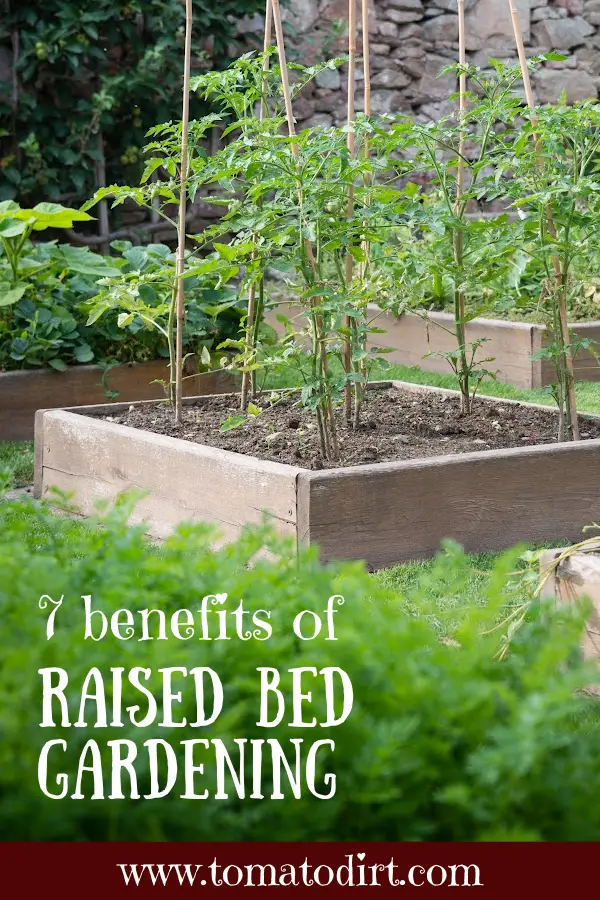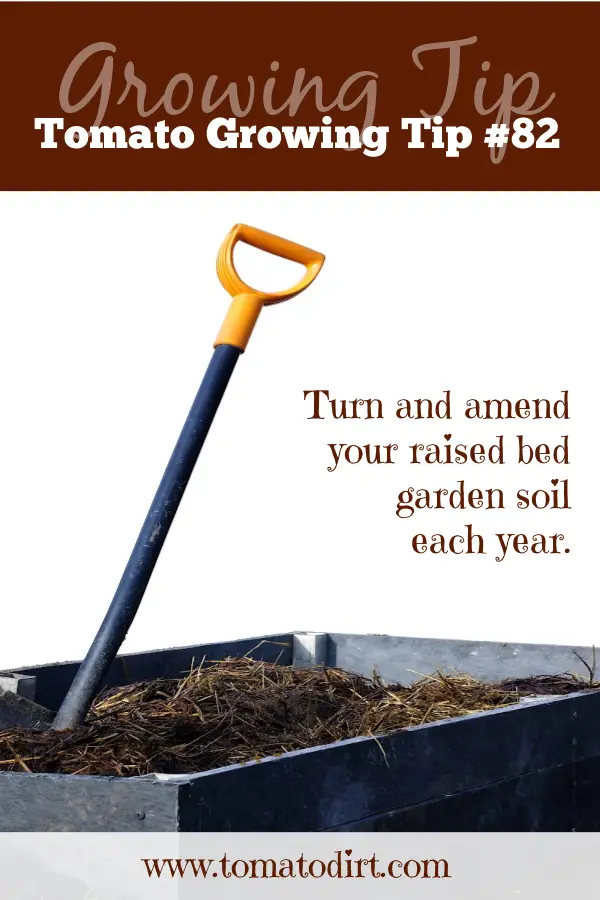FREE: 10 Must-Know Tomato Growing Tips Get The Guide
Read our affiliate disclosure here.
7 Benefits of Raised Beds for Gardening
Since 2010, Tomato Dirt has garnered 4.8+ million views, making it the web’s leading online source for growing tomatoes in the home garden. Award-winning writer and Tomato Dirt owner Kathy Widenhouse has helped thousands of home gardeners grow healthier tomatoes. Be one of them when you get Tomato Dirt’s Growing Guide here.
Updated 1.18.25
If you’re looking for a way to optimize your growing space and increase your harvest, then consider the benefits of raised beds for gardening.
It’s an approach that’s gaining more momentum, and not just in the wake of the pandemic when gardening popularity soared. People want to grow healthier food and save money. Yet even those who are time-pressed are making room in their schedules to grow tomatoes and vegetables in a raised bed. Raised bed gardening is projected to grow by 4.6% in the next decade.
These elevated gardening structures offer a host of benefits, particularly for cultivating tomatoes and other vegetables.
7 benefits of raised beds for gardening
1. Better soil drainage
Raised beds provide better drainage than traditional in-ground gardens. Gravity works in their favor. A raised bed is elevated above ground level, which allows excess water to drain away more easily from the soil. If you’ve filled the raised bed with quality soil, then plants receive just the right amount of moisture for optimal growth. Elevation prevents waterlogging and reduces the risk of root rot for tomatoes and other vegetables.
2. Better soil quality
Speaking of high-quality planting matter, raised beds allow you to create the perfect home for tomato plants and other veggies. Once you’ve worked the soil below the structure’s sides, fill your raised bed with a light, well-drained soil mixture comprised of 1/3 topsoil, 1/3 compost and 1/3 peat moss, coconut fiber, or coarse sand.
Your in-ground garden soil is likely not as ideal of an environment. By filling raised beds with a recipe of soil goodness, you can promote healthy root development and provides plants with essential nutrients, resulting in vigorous growth and abundant harvests.
3. Warmer soil temperature
The sides of a raised bed are exposed to the warmer air than its in ground counterparts. That means raised beds tend to warm up more quickly in the spring, allowing you to start planting earlier in the season. For heat-loving crops like tomatoes, this is an extra advantage. Warmer soil extends the growing season, allowing you to plant earlier than in ground. And since tomatoes like heat, warm soil encourages earlier fruit production.
4. Fewer weeds
Even after filling your raised bed with luscious, screened soil, weed seeds still manage to find a way to sprout and grow. However, since your bed is elevated, it’s easier for you to spot those invaders and remove them. You save time and effort while keeping tomato and vegetable plants free from competition for nutrients and water.
5. Better pest control
You can equip your raised bed with barriers or covers to protect plants from pests such as slugs, snails, and certain insects -- not as easy to manage with a larger in-ground plot. In addition, height makes a difference. The elevated bed deters burrowing pests like moles and voles and reduces the risk of damage to tomato and vegetable roots.
6. Accessibility
If you’ve got mobility issues or back problems, a raised bed makes it easier for you to enjoy gardening! But the same can be true for those without physical limitations. Your raised bed allows you to tend your plants without stooping or kneeling. Gardening can be a more enjoyable and comfortable experience.
7. Aesthetics
Raised beds can enhance the visual appeal of a garden or even your entire yard, providing structure and definition to the space. With creative designs and materials, they can become attractive focal points while efficiently maximizing planting space.
Additional considerations about raised beds for gardening
While you’re considering the benefits of raised beds for gardening, be sure to weigh additional considerations to this approach.
Initial cost
Building or purchasing raised beds can incur an upfront cost that may be higher than simply tilling a garden plot. However, the long-term benefits often outweigh this initial investment.
Maintenance
Raised beds reduce weeding time, but your elevated garden still needs attention. You’ll need to replenish the soil every year. Occasionally, you’ll need to repair or replace the sides of the bed
Limited space
For most tomatoes and vegetables, The depth of raised beds is sufficient to grow most tomatoes and vegetables. But your space will be limited. And while you’ll hopefully dig beneath the soil before you build a raised bed, root vegetables like carrots and potatoes may not thrive as well as they might in a ground level garden.
Compacted soil
Even if your raised bed is well constructed and well maintained, soil will compress and compact over time. You will need to be purposeful about turning the soil and adding organic matter each season to foster healthy root growth and drainage.
Microclimate effects
Raised beds can create a climate within a climate in your garden. The soil temperature and moisture levels are different than the conditions in the ground level soil. While this is not a problem – in fact, it can be a good thing – you need to be aware of the different conditions and tend to your raised bed crops accordingly.
One of the best benefits of raised beds for gardeners
The benefits of raised beds for gardening often outweigh any potential drawbacks – particularly if you have limited space or limited time to work in your garden. Debra Graff, for instance, uses succession crop planting from season to season in her raised beds and has increased her yield by up to 50% in the smaller space.
If you choose to try raised beds, you can have a healthy, thriving harvest, too.
More on Growing Tomatoes in Raised Beds
8 Low Cost Raised Garden Beds You Can DIY ...
16 Cost-Saving Tips for Do-It-Yourself Raised Garden Beds ...
6 Tips for Growing Tomatoes In Raised Garden Beds ...
Starting a Raised Bed Vegetable Garden FAQs ...
Materials for Your Raised Garden Bed: a primer ...
What to Put on Bottom of Raised Garden Bed ...
8 Guidelines for Growing Raised Bed Tomatoes ...
Raised Bed Gardening ideas on our Pinterest board ...
Return from 7 Benefits of Raised Bed Gardening to Tomato Dirt home
As an Amazon Associate and Rakuten Advertising affiliate I earn from qualifying purchases.
SHARE THIS PAGE:
FREE! 10 Must-Know Tomato Growing Tips: 20-page guide
Get yours here:





